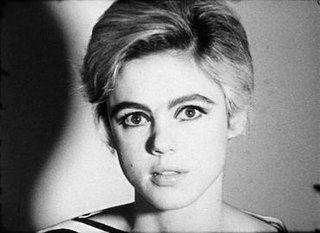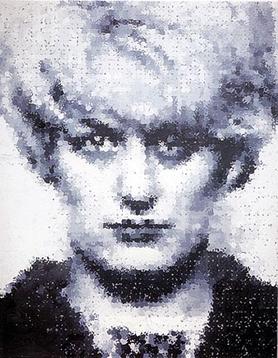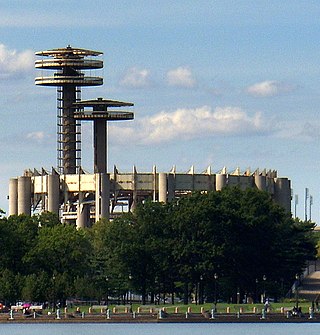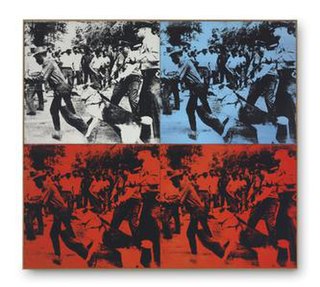Related Research Articles

Andy Warhol was an American visual artist, film director and producer. A leading figure in the pop art movement, Warhol is considered one the most important artists of the second half of the 20th century. His works explore the relationship between artistic expression, advertising, and celebrity culture that flourished by the 1960s, and span a variety of media, including painting, sculpture, photography, and filmmaking. Some of his best-known works include the silkscreen paintings Campbell's Soup Cans (1962) and Marilyn Diptych (1962), the experimental film Chelsea Girls (1966), the multimedia events known as the Exploding Plastic Inevitable (1966–67), and the erotic film Blue Movie (1969) that started the "Golden Age of Porn".

The Factory was Andy Warhol's studio in Manhattan, New York City, which had four locations between 1963 and 1987. The Factory became famed for its parties in the 1960s. It was the hip hangout spot for artists, musicians, celebrities, and Warhol's superstars. The original Factory was often referred to as the Silver Factory. In the studio, Warhol's workers would make silkscreens and lithographs under his direction.

Robert Indiana was an American artist associated with the pop art movement.

Elaine Frances Sturtevant, also known professionally as Sturtevant, was an American artist. She achieved recognition for her carefully inexact repetitions of other artists' works.

Empire is a 1965 American underground film by Andy Warhol. When projected according to Warhol's specifications, it consists of eight hours and five minutes of slow motion black-and-white footage of an unchanging view of New York City's Empire State Building. The silent film does not have conventional narrative or characters, and largely reduces the experience of cinema to the passing of time. Warhol stated that the purpose of the film was "to see time go by."

The Screen Tests are a series of short, silent, black-and-white film portraits by Andy Warhol, made between 1964 and 1966, generally showing their subjects from the neck up against plain backdrops. The Screen Tests, of which 472 survive, depict a wide range of figures, many of them part of the mid-1960s downtown New York cultural scene. Under Warhol's direction, subjects of the Screen Tests attempted to sit motionless for around three minutes while being filmed, with the resulting movies projected in slow motion. The films represent a new kind of portraiture—a slowly moving, nearly still image of a person. Warhol's Screen Tests connect on one hand with the artist's other work in film, which emphasized stillness and duration (for example, Sleep and Empire, and on the other hand with his focus after the mid-1960s on documenting his celebrity milieu in paintings and other works.

Campbell's Soup Cans is a work of art produced between November 1961 and June 1962 by the American artist Andy Warhol. It consists of thirty-two canvases, each measuring 20 inches (51 cm) in height × 16 inches (41 cm) in width and each consisting of a painting of a Campbell's Soup can—one of each of the canned soup varieties the company offered at the time. The works were Warhol's hand-painted depictions of printed imagery deriving from commercial products and popular culture and belong to the pop art movement.
Twentieth-century art—and what it became as modern art—began with modernism in the late nineteenth century.

Michael Bidlo is an American conceptual artist who employs painting, sculpture, drawing, performance, and other forms of "social sculpture."
In art, appropriation is the use of pre-existing objects or images with little or no transformation applied to them. The use of appropriation has played a significant role in the history of the arts. In the visual arts, "to appropriate" means to properly adopt, borrow, recycle or sample aspects of human-made visual culture. Notable in this respect are the readymades of Marcel Duchamp.

The Marilyn Diptych (1962) is a silkscreen painting by American pop artist Andy Warhol depicting Marilyn Monroe. The monumental work is one of the artist's most noted of the movie star.

Myra is a 1995 large painting created by Marcus Harvey which is a reproduction of the mugshot of Myra Hindley shortly after she was arrested for her participation in the Moors murders. It was displayed at the Sensation exhibition of Young British Artists at the Royal Academy of Art in London from 8 September to 28 December 1997.

The New York State Pavilion is a pavilion at Flushing Meadows–Corona Park in Queens, New York City, New York. Constructed for the 1964 New York World's Fair, it was designed by the architects Philip Johnson and Richard Foster, with Lev Zetlin as the structural engineer. The pavilion consists of three reinforced concrete-and-steel structures: the Tent of Tomorrow, observation towers, and Theaterama. It is owned by the New York City Department of Parks and Recreation and listed on the National Register of Historic Places.

Steven Alan Kaufman was an American pop artist, fine artist, sculptor, stained glass artist, filmmaker, photographer and humanitarian. His entry into the world of serious pop art began in his teens when he became an assistant to Andy Warhol at The Factory studio, who nicknamed him "SAK". Kaufman eventually executed such pieces as a 144-foot-long canvas which later toured the country.

Michael McKenzie is an American artist and writer. His mother a fourth generation Irish/German and his father of recent Scottish immigrants. He began writing, drawing, painting and publishing at a young age, his first publication, at age 5, was Two Cents Plain, a four-page magazine he made using a mimeograph machine at his father's office. A fluke meeting at the 1964 World's Fair with his grandmother introduced him to Philip Johnson, Andy Warhol and Robert Indiana, all three of whom he would later work with.

Race Riot is a 1964 acrylic and silkscreen painting by the American artist Andy Warhol that he executed in 1964. It fetched $62,885,000 at Christie's in New York on 13 May 2014.

Orange Prince is a painting by American artist Andy Warhol of Prince, the American singer, songwriter, record producer, multi-instrumentalist, actor, and director. The painting is one of twelve silkscreen portraits on canvas of Prince created by Warhol in 1984, based on an original photograph provided to Warhol by Vanity Fair. The photograph was taken by Lynn Goldsmith. These paintings and four additional works on paper are collectively known as the Prince Series. Each painting is unique and can be distinguished by colour.

Suicide (Purple Jumping Man) is a 1963 silkscreen painting by an American pop artist, Andy Warhol. It is currently in the collection of the Tehran Museum of Contemporary Art in Tehran.

Reigning Queens is a 1985 series of silkscreen portraits by American artist Andy Warhol. The screen prints were presented as a portfolio of sixteen; four prints each of the four queens regnant. The subjects were Queen Elizabeth II of the United Kingdom and the other Commonwealth realms, Queen Beatrix of the Netherlands, Queen Ntfombi Twala of Swaziland and Queen Margrethe II of Denmark.

Andy Mouse is a series of silkscreen prints created by American artist Keith Haring in 1986. The character Andy Mouse is a fusion between Disney's Mickey Mouse and Andy Warhol. The series consists of four silkscreen prints on wove paper, released in an edition of 30 per colorway, all signed and dated in pencil by Haring and Warhol.
References
- ↑ "13 Most Wanted Men: Andy Warhol and the 1964 World's Fair / Apr 27 2014 / Sep 7 2014". Queens Museum . Retrieved October 13, 2020.
- ↑ "Past Exhibition: 13 Most Wanted Men: Andy Warhol and the 1964 World's Fair, September 27, 2014–January 4, 2015". The Andy Warhol Museum . Retrieved October 13, 2020.
- ↑ Buchloh, Benjamin H. D (2001). "Andy Warhol's One Dimensional Art: 1956-1966". Andy Warhol. MIT Press. p. 46. ISBN 9780262632423.